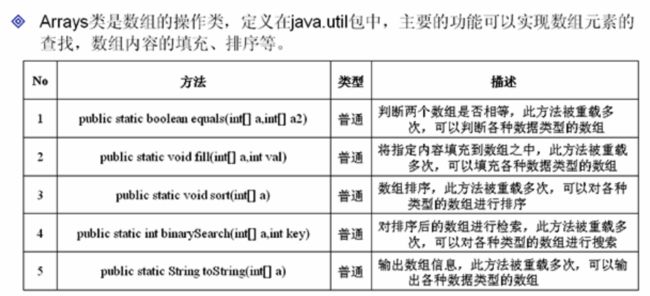Java常用类库--Arrays、比较器(comparable、Comparator)
1、Arrays类
Arrays表示数组的操作类,直接定义在java.util包中
import java.util.* ;
public class ArraysDemo{
public static void main(String arg[]){
int temp[] = {3,4,5,7,9,1,2,6,8} ; // 声明一个整型数组
Arrays.sort(temp) ; // 进行排序的操作
System.out.print("排序后的数组:") ;
System.out.println(Arrays.toString(temp)) ; // 以字符串输出数组
// 如果要想使用二分法查询的话,则必须是排序之后的数组
int point = Arrays.binarySearch(temp,3) ; // 检索位置
System.out.println("元素‘3’的位置在:" + point) ;
Arrays.fill(temp,3) ;// 填充数组
System.out.print("数组填充:") ;
System.out.println(Arrays.toString(temp)) ;
}
};
2、Comparable接口的作用
class Student implements Comparable<Student> { // 指定类型为Student
private String name ;
private int age ;
private float score ;
public Student(String name,int age,float score){
this.name = name ;
this.age = age ;
this.score = score ;
}
public String toString(){
return name + "\t\t" + this.age + "\t\t" + this.score ;
}
public int compareTo(Student stu){ // 覆写compareTo()方法,实现排序规则的应用
if(this.score>stu.score){
return -1 ;
}else if(this.score<stu.score){
return 1 ;
}else{
if(this.age>stu.age){
return 1 ;
}else if(this.age<stu.age){
return -1 ;
}else{
return 0 ;
}
}
}
};
public class ComparableDemo01{
public static void main(String args[]){
Student stu[] = {new Student("张三",20,90.0f),
new Student("李四",22,90.0f),new Student("王五",20,99.0f),
new Student("赵六",20,70.0f),new Student("孙七",22,100.0f)} ;
java.util.Arrays.sort(stu) ; // 进行排序操作
for(int i=0;i<stu.length;i++){ // 循环输出数组中的内容
System.out.println(stu[i]) ;
}
}
};

3、分析比较器的排序原理
下面自己手工实现一个二叉树的比较算法。
为了操作方便,此处使用Integer类完成。
public class ComparableDemo02{
public static void main(String args[]){
Comparable com = null ; // 声明一个Comparable接口对象
com = 30 ; // 通过Integer为Comparable实例化
System.out.println("内容为:" + com) ; // 调用的是toString()方法
}
};
class BinaryTree{
class Node{ // 声明一个节点类
private Comparable data ; // 保存具体的内容
private Node left ; // 保存左子树
private Node right ; // 保存右子树
public Node(Comparable data){
this.data = data ;
}
public void addNode(Node newNode){
// 确定是放在左子树还是右子树
if(newNode.data.compareTo(this.data)<0){ // 内容小,放在左子树
if(this.left==null){
this.left = newNode ; // 直接将新的节点设置成左子树
}else{
this.left.addNode(newNode) ; // 继续向下判断
}
}
if(newNode.data.compareTo(this.data)>=0){ // 放在右子树
if(this.right==null){
this.right = newNode ; // 没有右子树则将此节点设置成右子树
}else{
this.right.addNode(newNode) ; // 继续向下判断
}
}
}
public void printNode(){ // 输出的时候采用中序遍历
if(this.left!=null){
this.left.printNode() ; // 输出左子树
}
System.out.print(this.data + "\t") ;
if(this.right!=null){
this.right.printNode() ;
}
}
};
private Node root ; // 根元素
public void add(Comparable data){ // 加入元素
Node newNode = new Node(data) ; // 定义新的节点
if(root==null){ // 没有根节点
root = newNode ; // 第一个元素作为根节点
}else{
root.addNode(newNode) ; // 确定是放在左子树还是放在右子树
}
}
public void print(){
this.root.printNode() ; // 通过根节点输出
}
};
public class ComparableDemo03{
public static void main(String args[]){
BinaryTree bt = new BinaryTree() ;
bt.add(8) ;
bt.add(3) ;
bt.add(3) ;
bt.add(10) ;
bt.add(9) ;
bt.add(1) ;
bt.add(5) ;
bt.add(5) ;
System.out.println("排序之后的结果:") ;
bt.print() ;
}
};
4、Comparator比较器

import java.util.* ;
class Student{ // 指定类型为Student
private String name ;
private int age ;
public Student(String name,int age){
this.name = name ;
this.age = age ;
}
public boolean equals(Object obj){ // 覆写equals方法
if(this==obj){
return true ;
}
if(!(obj instanceof Student)){
return false ;
}
Student stu = (Student) obj ;
if(stu.name.equals(this.name)&&stu.age==this.age){
return true ;
}else{
return false ;
}
}
public void setName(String name){
this.name = name ;
}
public void setAge(int age){
this.age = age ;
}
public String getName(){
return this.name ;
}
public int getAge(){
return this.age ;
}
public String toString(){
return name + "\t\t" + this.age ;
}
};
class StudentComparator implements Comparator<Student>{ // 实现比较器
// 因为Object类中本身已经有了equals()方法
public int compare(Student s1,Student s2){
if(s1.equals(s2)){
return 0 ;
}else if(s1.getAge()<s2.getAge()){ // 按年龄比较
return 1 ;
}else{
return -1 ;
}
}
};
public class ComparatorDemo{
public static void main(String args[]){
Student stu[] = {new Student("张三",20),
new Student("李四",22),new Student("王五",20),
new Student("赵六",20),new Student("孙七",22)} ;
java.util.Arrays.sort(stu,new StudentComparator()) ; // 进行排序操作
for(int i=0;i<stu.length;i++){ // 循环输出数组中的内容
System.out.println(stu[i]) ;
}
}
};



